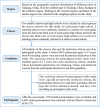Sex comparison of the association between weight-adjusted waist index and physical fitness index: a cross-sectional survey of adolescents in Xinjiang, China
- PMID: 40437112
- PMCID: PMC12119831
- DOI: 10.1038/s41598-025-03131-3
Sex comparison of the association between weight-adjusted waist index and physical fitness index: a cross-sectional survey of adolescents in Xinjiang, China
Abstract
The low level of physical fitness among Chinese adolescents has a negative impact on schooling and health. The weight-adjusted waist index (WWI) has attracted much attention as a novel indicator for assessing body composition. However, little research has been conducted on the association between WWI and the physical fitness index (PFI) among adolescents in the Xinjiang region of western China. A randomized whole-cluster sampling method was used to assess 4496 adolescents aged 12-17 years in Xinjiang, China. The assessment indexes included height, weight, waist circumference, grip strength, sit-up, standing long jump, sit and reach, 50 m dash, 20-mSRT, and the WWI and PFI were calculated. One-way analysis of variance (ANOVA), Kruskal Wallis rank sum test, Pearson correlation analysis, and curvilinear regression analysis were used to analyze the correlations that existed between WWI and PFI. The differences in PFI between different WWI subgroups of Chinese adolescents in Xinjiang were all statistically significant when compared with each other (H-values of 57.058, 137.515, and 19.443, P < 0.01). The analyzed results did not change according to age. Similarly, the same trend was observed for boys and girls. Overall, WWI showed an inverted "U" curve relationship with PFI, and the effect of increased WWI on PFI was more pronounced in boys than in girls. When the WWI is 8.8, the PFI is at its highest level, i.e. 0.131. The relationship between WWI and PFI in Chinese adolescents in Xinjiang showed an inverted "U" curve, with lower or higher WWI negatively affecting PFI, and the effect on boys was more obvious than that on girls. In the future, the WWI level of Chinese adolescents in Xinjiang should be effectively controlled to keep it within a reasonable range, promote the development of physical fitness, and safeguard physical and mental health.
Keywords: Adolescents; Associations; Physical fitness index; Weight-adjusted waist index; Xinjiang.
© 2025. The Author(s).
Conflict of interest statement
Declarations. Competing interests: The authors declare no competing interests. Informed consent: Informed consent was obtained from all subjects involved in the study. Institutional review board statement: This study was conducted by the principles of the Declaration of Helsinki. Informed consent was obtained from parents or guardians before the assessment of participants in this study, and participants volunteered to be assessed for this study. Approved by the Human Ethics Committee of East China Normal University (HR 475–2020).
Figures



Similar articles
-
Association between weight-adjusted waist index and 20-meter shuttle run test in Chinese children and adolescents: a multicenter cross-sectional survey.Front Public Health. 2025 Apr 22;13:1550741. doi: 10.3389/fpubh.2025.1550741. eCollection 2025. Front Public Health. 2025. PMID: 40331112 Free PMC article.
-
Benefits of normal body mass index on physical fitness: A cross-sectional study among children and adolescents in Xinjiang Uyghur Autonomous Region, China.PLoS One. 2019 Aug 15;14(8):e0220863. doi: 10.1371/journal.pone.0220863. eCollection 2019. PLoS One. 2019. PMID: 31415603 Free PMC article.
-
Sex differences in the association between waist circumference and physical fitness index among Tajik adolescents in the Pamir Mountains of Xinjiang, China: an observational study.BMC Sports Sci Med Rehabil. 2024 Sep 9;16(1):188. doi: 10.1186/s13102-024-00979-2. BMC Sports Sci Med Rehabil. 2024. PMID: 39252113 Free PMC article.
-
Relationship between body mass index and physical fitness of children and adolescents in Xinjiang, China: a cross-sectional study.BMC Public Health. 2022 Sep 5;22(1):1680. doi: 10.1186/s12889-022-14089-6. BMC Public Health. 2022. PMID: 36064657 Free PMC article.
-
Association between Weight-Adjusted Waist Index and depressive symptoms: A nationally representative cross-sectional study from NHANES 2005 to 2018.J Affect Disord. 2024 Apr 1;350:49-57. doi: 10.1016/j.jad.2024.01.104. Epub 2024 Jan 12. J Affect Disord. 2024. PMID: 38220117 Review.
References
-
- Antwi, F. et al. The effectiveness of web-based programs on the reduction of childhood obesity in school-aged children: A systematic review. JBI Libr. Syst. Rev.10, 1 (2012). - PubMed
-
- Cardon, G. & Salmon, J. Why have youth physical activity trends flatlined in the last decade? Opinion piece on global trends in insufficient physical activity among adolescents: a pooled analysis of 298 population-based surveys with 1.6 million participants by Guthold et al. J. Sport Health Sci.9, 335 (2020). - PMC - PubMed
-
- Dykstra, B. J., Griffith, G. J., Renfrow, M. S., Mahon, A. D. & Harber, M. P. Cardiorespiratory and muscular fitness in children and adolescents with obesity. Curr. Cardiol. Rep.26, 349 (2024). - PubMed
Publication types
MeSH terms
LinkOut - more resources
Full Text Sources
Medical

